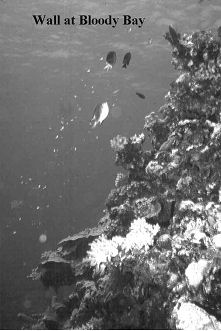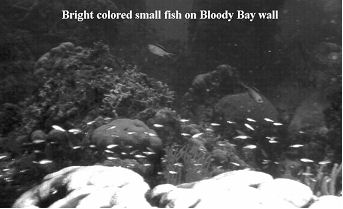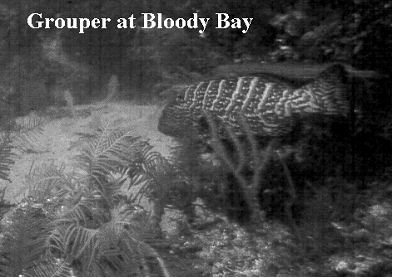|
 |
|
Diving the Bloody Bay Wall Superlatives are simply not enough! Diving the “Bloody Bay” wall was a nearly religious experience. Come with me and relive the trip! A “wall” is a coral reef edge that drops sheer to great depths from a shallow, nearly flat top. These walls are among the sheerest cliffs found in nature. Very often they occur in little steps or have benches every 50 to 100 feet down but not the wall at Bloody Bay, Little Cayman. As a matter of fact there is a similar site called Three Fathom Wall as well. I stepped off the stern of a dive boat anchored in 25 feet of water and looked straight down as far as one could see in the The Cayman Islands, three small islands south of Cuba, are on the south side of the Cayman Trough or Trench. It is part of the Cayman/Puerto Rico Trench system, the deepest part of the Atlantic Ocean. Except for Cuba, the islands on the inside or convex side of the Trench are referred to as portions of an “island arc”. Movement along the Trench, where the south side is moving east relative to the north side, has resulted in the Oriente Province of Cuba being separated from Hispaniola. Hispaniola and possibly Puerto Rico were probably once joined to Cuba and the east/west movement along the Trench has separated them over millions of years. The above has no bearing on the “wall” and its sheer beauty. That is a function of the coral animals and how they grow in warm tropical water. The wall is a reality and an outstanding place to dive. Add to that the almost undeveloped nature of Little Cayman, an island 10 miles long and 2 miles wide, and you have the makings of an extraordinary diving vacation, away from the flesh pots and hustle of so many resorts. With a few dozen permanent inhabitants, no island wide electricity, and mostly radio for communication and you can relax after diving with only a modicum of nighttime noise and nightlife. Now about that diving! With the water so clear that the boat, 80 feet above us, looked like it was suspended in the air, and so warm that we were still comfortable after hours in the sea, conditions were nearly perfect. I dove mostly on the upper edge of the wall because the nearest decompression chamber was two hours away by boat and an hour if you called in an airplane. I dove quite conservatively. Besides, the most life is in the upper 60 feet or so and I wanted a long time on bottom. The fauna and flora are typical of the Caribbean/West Indian area and include most of the forms we see in Florida plus some that are rare on the Florida side of the Gulf Stream. These include critters like the royal gramma, blackcap basslet, black coral and so on. Unlike the Florida reefs north of Miami, which are technically “soft coral and sponge” reefs, the Cayman reefs have luxuriant growths of hard or stony corals, enormous and beautiful sponges and all the myriad fish and invertebrates of all colors that make the scenery so spectacular. Caverns abound, through which the diver may glide beneath walls of coral festooned with critters that avoid direct sunlight. In a thousand cracks and crevices are fish, shrimp, crabs, crinoids, brittle stars and anything else that will fit. Hundreds of bright small fish in purple, gold, red, green, blue and black are always in sight. Some, only an inch or two long, will dart out and strike you, the invader of their territory. Others will try to clean bits of cuticle from your fingernails if you hold still. Others dart into holes in the reef only to reappear a few feet away. A giant grouper, perhaps 50 to 60 lbs. in weight, swam up to within a foot of my camera, which was unfortunately set to take close-ups just 5½ inches away. I tried to get a picture of it’s eye but it only wanted head and shoulder portraits today, thank you. Spearfishing is prohibited and the divemaster insures that the prohibition is enforced so that the next diver can have the excitement of playing with a huge grouper a few inches away. One of our divers saw a lobster so big it spooked her. After we returned to shore, the divemaster took me to a shallow bay spot where I got conch for the whole crowd in 20 minutes as the sun went down. They were cooked, Cayman style, by our hosts who put on a tremendous diver’s dinner for us. We had marinated raw conch (delicious), yucca root, fried coconut chips and breadfruit in addition to spicy hot Cayman cuisine. Like all Caymanians they were jacks-of-all-trades because there were no corner welding shops, auto repair shops or Home Depots. A handsome, gracious people, they made our stay memorable. Now for diving the wall! On my last trip I spent more than an hour and two rolls of film taking pictures from 5½ inches away, near the top of the wall. I never turned toward the abyss. Everything I dealt with was only a foot or so away except for a few minutes on the boat changing film. When I finished my second roll and turned to enjoy the view, panic seized me! There was nothing there but a sheer drop-off into who knows how many feet of clear deep blue water. I literally grabbed the nearest coral knob and flattened myself against the solid wall. The psychological shock of going from a solid wall, only a foot away, to nothing solid or appreciable was just too great. I had never had this problem before. On an expedition to the fabled “South Seas” I have dived to 90 feet in the open ocean, under a research vessel in 14,000 feet of water, collecting little plankton creatures and enjoyed floating in midair, sorry, I mean midwater, with no hesitation or fear. Well, this time I carried on a dialog between my brain, the rational one, and the rest of me. “Come on Ray, you ain’t gonna fall, you’re in water” says the brain. “To hell you say. I’m staying right here!” said the rest of me. “Use your head, Ray, you’ve swum in open water a hundred times before and never fell. It’s no sweat!” “You go on out there if you want to, big shot, but I’m staying right here,” said body. “Come on, it’s like being in a plane crash. If you don’t do it now you will probably never do it again.” “OK, you SOB, but if I fall, I’m taking you with me.” Beware nitrogen narcosis, oxygen toxicity and carbon dioxide poisoning. Follow established procedures while diving and make the correct assumption that most of the rules are intended to keep you from killing yourself. So we shoved off from the face As I said, it was almost a religious experience, and I highly recommend it to all. Go to Little Cayman for the dive of your life!!!!!! |
|
[Home] [Cirriculum Vitae] [FAU Page] [Ray's Corner] |




 gin clear water off Little Cayman. If I had stepped off the bow I would have been in 25 to 35 feet of water and the boat was only 40 feet long! Looking down I saw deep blue water turning almost black straight below. It was more than spectacular.
gin clear water off Little Cayman. If I had stepped off the bow I would have been in 25 to 35 feet of water and the boat was only 40 feet long! Looking down I saw deep blue water turning almost black straight below. It was more than spectacular.

 of the cliff and floated in midwater, looking back at the wall and down into the depths. When I wanted to rise I inhaled. When I wanted to descend I exhaled. When I wanted to hover I took in just enough air to suspend me in midwater. In a few moments the terror was gone and I let go of “brain”. I spent the rest of my dive enjoying the huge sponges and soft corals and the sight of all our divers spread out along the face of the wall at a variety of depths. Some were more than 100 feet away.
of the cliff and floated in midwater, looking back at the wall and down into the depths. When I wanted to rise I inhaled. When I wanted to descend I exhaled. When I wanted to hover I took in just enough air to suspend me in midwater. In a few moments the terror was gone and I let go of “brain”. I spent the rest of my dive enjoying the huge sponges and soft corals and the sight of all our divers spread out along the face of the wall at a variety of depths. Some were more than 100 feet away.